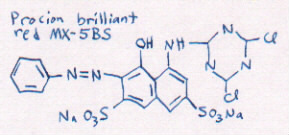

Food dyes, such as those in unsweetened Kool-Aid, can be used as acid dyes, for protein fibers, such as wool, or for nylon. Heat is required. They do not yield satisfactory results when used on cellulose fibers such as cotton, because they lack the chlorine atoms of the Procion dyes that can react with cellulose, such as is found in cotton, for example.
| Kool-Aid dye | Procion dye |
|---|---|

|
 |
The remaining certified food dyes that are legal, in the US, to use in a food product such as Kool-Aid, are brilliant blue FCF (FD&C Blue #1), sunset yellow FCF (FD&C yellow #6), indigotine (FD&C blue #2), fast green FCF (FD&C green #3), erythrosine (FD&C red #3), and tartrazine (FD&C yellow #5). None of these is a reactive dye; all lack the dichlorotriazine structure of Procion MX dyes.
Procion dyes are quite safe when used as directed - never consume the dye, nor breathe the dye powder - but have not been tested for safety when consumed. It is important to always follow reasonable safety precautions. The majority of artificial food colorings that have been used over the years have turned out to be at least somewhat harmful when eaten, and have subsequently been banned for use in food.
 Back to list of FAQs
Back to list of FAQs
All of the pages on this site are copyright ©1998‑2025 Paula E. Burch, Ph.D.
Page created: August 14, 1999;
Last updated: September 4, 2006;
Downloaded: Tuesday, December 09, 2025